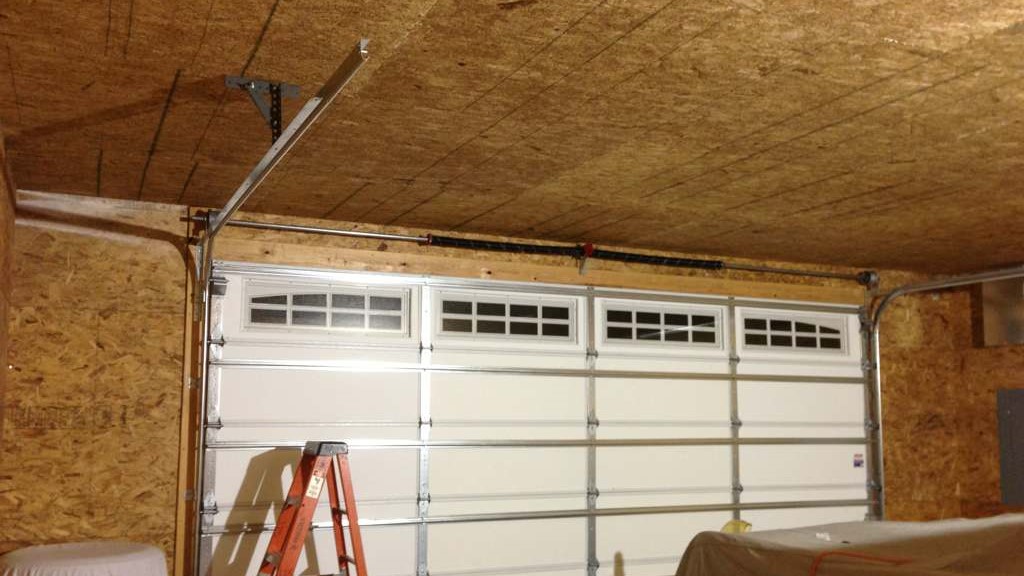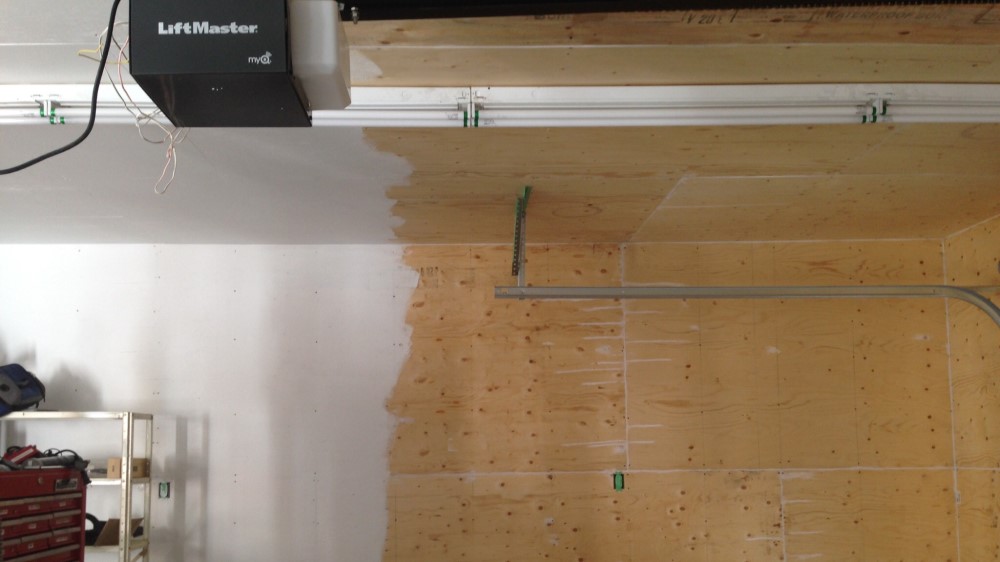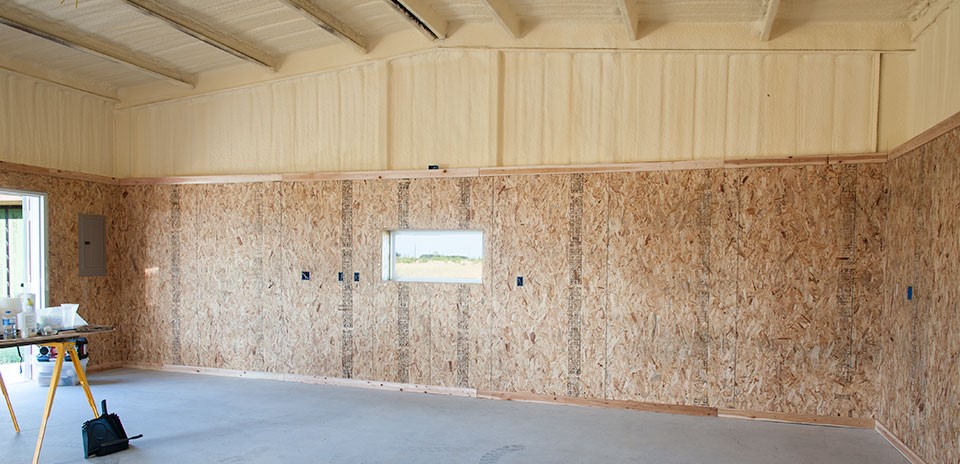If you have spent enough time wondering what you are going to put on the walls of your garage cave, you have probably thought about the different options. One of those is OSB. But is it the ideal material for the walls in your garage? If you have ever wondered if OSB is right for the walls inside of your garage, we have a detailed list of the pros, cons, and board competitors!
Can you use OSB for garage walls? OSB is an excellent choice for garage walls because it is inexpensive, strong, and easy to install. The main reason to choose something else would be because of how it looks.
Let’s take a look at OSB and why it is such a good contender for your garage walls.
Table of Contents
What Is OSB Anyhow?
OSB stands for Oriented Strand Board. When you look at OSB, it just looks like a bunch of wood chips that have been glued together. Well, that’s because, essentially, it is.
OSB uses large wood shavings from a processed tree that are soaked in resins and glues. These materials are then pressed together to form a large sheet. The sheets are then cut to size and dried in industrial ovens, creating a strong and flexible construction material.
While some older carpenters may remember a day when OSB was a questionable material, you’ll be hard-pressed not to find it being used in home construction today. Home sheathing and subfloors in single-family home construction are commonly made of OSB.
Pros of Using OSB for Garage Walls

1. The price is right. OSB is cheaper than many other options, including plywood of the same thickness, making it more economical. Cost is important when you need to buy in bulk.
2. OSB is strong. The shear values mean that OSB can be used in not just flooring and sheathing, but also in the webbing of wooden structural beams.
3. OSB uses the whole tree. The tree is chipped up in its entirety and used for the boards. Since it doesn’t need to shave pretty sheets from the tree, it wastes far less wood than plywood.
4. OSB is versatile. You can staple, nail, and screw into OSB. That makes it easy to mount all of your decorations and lighter tools!
5. OSB does not absorb moisture easily. It takes a lot of water, usually constant dripping or submersion, before you start to see it take on water.
6. It is readily available. You can go to any hardware or outlet store that sells lumber and find stacks upon stacks of the stuff in various thicknesses.
7. No special tools required. All you need is a way to cut the OSB and screw it into the studs. No mud, no tape, no sanding.
[googleadsycc adunit=”inarticle”]
Cons of Using OSB for Garage Walls
1. Let’s face it, OSB isn’t winning any beauty pageants. If you’re looking for a nice finished look, this isn’t going to be your first choice. If you want your space to look like a workshop while still being functional, you’ll be really happy with it.
2. If you ever sell your home, the chances are that the look of OSB is going to hold less value than plywood or drywall to prospective buyers that don’t know what they are seeing.
3. If OSB does soak up moisture, it takes a very long time to dry out, and this can cause the wood to rot. Lots of airflow is needed to help dry it out properly. Also, OSB swelling tends to occur at the edges and is irreparable.
4. Some OSB does have a toxicity warning. The materials used in the glue to bind the woods sometimes vary, and some of those variations has a risk of off-gassing (releasing into the air as a gas over time) formaldehyde.
a. Urea-formaldehyde (UF): The OSB containing UF should not be used indoors. The levels of off-gassing formaldehyde are much higher and can be unsafe, especially with lower airflow areas.
b. Phenol-formaldehyde (PF): The OSB containing PF still releases formaldehyde, but at rates that are so small they are not considered. Most of this off-gassing has finished before the OSB could even make it to the lumber yard or hardwood store. This material is subject to high standards as it is used in most subflooring and sheathing in homes.
What Does This Mean for Your Garage Cave?

OSB is not just a cheap material, but it is effective for most applications. You’ll be able to hang things on it, mount shelves to it, and you won’t have to worry very much about damaging it. The dangers of moisture damage are not going to affect most garage cave builds.
[googleadsycc adunit=”inarticle”]
OSB VS. Alternate Materials
There are plenty of other options for your garage walls, but they are not all made equally. Each have their particular form and function, so you’ll have to decide what is best for you.
Plywood
Plywood is lighter, prettier, and stiffer than OSB, but it is more expensive. It also absorbs moisture easier than OSB, though it does dry out much faster and easier.
Drywall
Finished drywall looks great and brings the feeling of a home to your space! Unfortunately, it isn’t as easy to mount things without using anchors and hitting studs. Drywall is harder to install and easier to damage, but you can also patch it in case of accidents.
Melamine Pegboard
Melamine pegboard turns your walls into ready tool racks. However, it isn’t as strong, isn’t pretty, and doesn’t allow for a multitude of mounting options.
Corrugated Metal
You can make your garage cave look like an old metal shed! It looks cool, but it is a lot more difficult to cut to size, as well as more difficult to create a sturdy and flush mount.
Wood Panels
Wooden panels come in many shapes and styles, such as shingles or panels. They have a classic, rustic, and a pleasing look. It is also far more difficult and time-consuming to install and creates some difficulty in locating studs and mounting things securely, especially heavier objects.
Plastic Panels
There is a multitude of prefabricated plastic panels on the market today. They have a unique look but are far more difficult to mount to. If you’re going for the mad scientist look, this may be the one for you!
[googleadsycc adunit=”inarticle”]
Why Not Both?
Mixing and matching materials like OSB and others are common. Although the combination of OSB and plywood is usually done in the less visible exterior of homes, it may be an idea of value for you in your situation.
Contractors often use pressure treated plywood as the first foot or two at the base of a house or under the windowsill. This is because these areas are where most of the moisture contact will happen, and the plywood helps to alleviate possible damage down the road. If you’re working with a lot of wet materials, this method may be for you.
If you want more information on how that works, check out this video.
Maybe you want a section of the wall to be pegboard for tools? Maybe you’d like one wall to look like the entrance to an old woodshed? You can mix the different looks to create unique, sharp, and functional walls for your creative space.
OSB, A Diamond in the Rough
So, can you use OSB for garage walls? Not only can you use it, you probably should! It will certainly satisfy the structural needs you may have, and maybe even be the rough aesthetic you’re looking for. The flexibility of the material certainly gives you many options for experimentation and customization of your space.



0 Comments